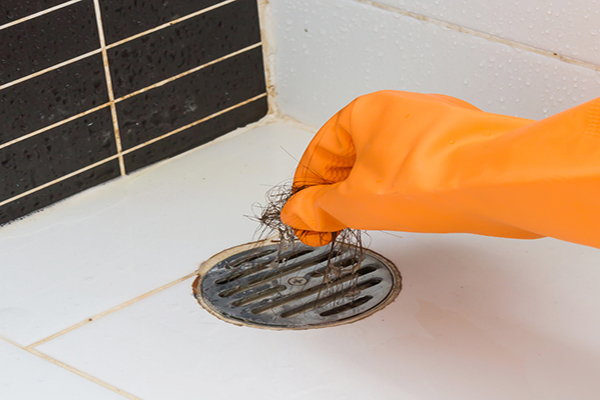Maintaining a functional shower drain is a fundamental aspect of household hygiene. Few things are as irksome as standing ankle-deep in water during your shower due to a clogged drain, often caused by the accumulation of hair. In this comprehensive guide, we will delve into a variety of techniques to unclog your shower drain. From basic maneuvers to DIY remedies, we’ll equip you with the knowledge to tackle the issue head-on.
Gather Necessary Materials
Before embarking on your drain-clearing mission, ensure you have the essential tools on hand. This includes rubber gloves to protect your hands, a plunger for the initial attempt, a zip-it tool or drain snake for more stubborn clogs, and household items like baking soda, vinegar, and boiling water.
Precautions:
Safety should always be a priority. Begin by donning rubber gloves and removing any visible debris near the drain entrance. This not only ensures a clean workspace but also prevents accidental injury.
Using a Plunger
The plunger is a classic tool for dislodging simple clogs. Start by sealing the overflow drain with a wet cloth. Position the plunger over the drain, ensuring a tight seal, and perform rhythmic push-and-pull motions. Repeat until water starts to drain, indicating a successful unclogging.
Using a Zip-it Tool or Drain Snake
For more resilient clogs deeper in the pipes, a zip-it tool or drain snake comes to the rescue. Insert the tool, twist it to catch hair and debris, and slowly pull it out. This method is effective in capturing material that the plunger might miss. Dispose of the extracted debris responsibly.
Baking Soda and Vinegar Mixture
For a natural and chemical-free solution, combine a cup of baking soda with a cup of vinegar. Pour this mixture down the drain and let it sit for 15-30 minutes. The fizzing reaction helps break down organic matter. Follow up with a flush of boiling water to clear the drain.
Boiling Water
Boil a pot of water and pour it slowly down the drain. This hot water can melt and wash away soap scum and hair that may be causing the blockage. Repeat the process if needed, allowing a few minutes between pours.
Routine Maintenance Tips
To stave off future clogs, invest in a drain strainer. This simple device catches hair and debris before it reaches the pipes. Make it a habit to clean the strainer regularly. Additionally, perform routine maintenance by pouring a mixture of baking soda and vinegar down the drain, followed by boiling water.
Professional Help
If your efforts prove futile and the drain remains obstinately clogged, it might be time to seek professional plumbing assistance. It’s advisable to refrain from using harsh chemical drain cleaners, as they can damage pipes and pose environmental hazards.
FAQs:
Q1: Can I use chemical drain cleaners?
A1: It’s not recommended, as these can be harsh on pipes and harmful to the environment. Opt for more natural solutions.
Q2: How often should I perform drain maintenance?
A2: Aim for monthly maintenance to prevent clogs. Consider using a drain strainer regularly.
Q3: Is there a specific method for preventing hair clogs?
A3: Use a drain strainer to catch hair and debris, and clean it regularly. Performing routine maintenance with baking soda and vinegar helps too.
Conclusion:
Maintaining an unobstructed shower drain is a small yet vital task for any homeowner. With the arsenal of effective methods and routine maintenance tips provided, you can ensure your shower drains remain free-flowing. Proactive prevention, coupled with the willingness to seek professional assistance if needed, will save you from potential plumbing headaches. So, roll up your sleeves, follow these steps, and revel in the joy of a smoothly draining shower. Happy plumbing!

A group of home improvement enthusiasts and bathroom design experts, combines in-depth knowledge and a shared passion to deliver engaging, informative content that guides readers through the world of bathroom innovation and style.

Leave a Reply